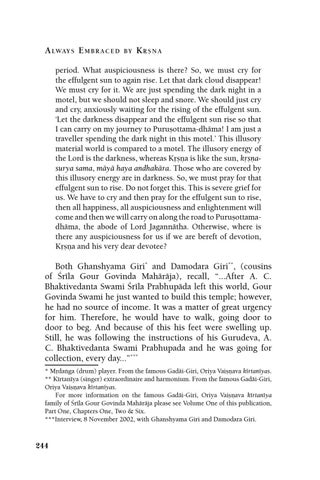A lway s E m b r a c e d
by
Kåñëa
period. What auspiciousness is there? So, we must cry for the effulgent sun to again rise. Let that dark cloud disappear! We must cry for it. We are just spending the dark night in a motel, but we should not sleep and snore. We should just cry and cry, anxiously waiting for the rising of the effulgent sun. ‘Let the darkness disappear and the effulgent sun rise so that I can carry on my journey to Puruñottama-dhäma! I am just a traveller spending the dark night in this motel.’ This illusory material world is compared to a motel. The illusory energy of the Lord is the darkness, whereas Kåñëa is like the sun, kåñëasurya sama, mäyä haya andhakära. Those who are covered by this illusory energy are in darkness. So, we must pray for that effulgent sun to rise. Do not forget this. This is severe grief for us. We have to cry and then pray for the effulgent sun to rise, then all happiness, all auspiciousness and enlightenment will come and then we will carry on along the road to Puruñottamadhäma, the abode of Lord Jagannätha. Otherwise, where is there any auspiciousness for us if we are bereft of devotion, Kåñëa and his very dear devotee?
Both Ghanshyama Giri* and Damodara Giri**, (cousins of Çréla Gour Govinda Mahäräja), recall, “...After A. C. Bhaktivedanta Swami Çréla Prabhupäda left this world, Gour Govinda Swami he just wanted to build this temple; however, he had no source of income. It was a matter of great urgency for him. Therefore, he would have to walk, going door to door to beg. And because of this his feet were swelling up. Still, he was following the instructions of his Gurudeva, A. C. Bhaktivedanta Swami Prabhupada and he was going for collection, every day...”*** * Mådaìga (drum) player. From the famous Gadäi-Giri, Oriya Vaiñëava kértanéyas. ** Kértanéya (singer) extraordinaire and harmonium. From the famous Gadäi-Giri, Oriya Vaiñëava kértanéyas. For more information on the famous Gadäi-Giri, Oriya Vaiñëava kértanéya family of Çréla Gour Govinda Mahäräja please see Volume One of this publication, Part One, Chapters One, Two & Six. ***Interview, 8 November 2002, with Ghanshyama Giri and Damodara Giri.
244





